Content
- 1 Varieties of irises
- 2 Bearded irises
- 3 Dwarf irises
- 4 Bulbous irises
- 5 Siberian irises
- 6 Swamp irises
- 7 Japanese irises
- 8 Medium, tall and miniature bearded irises
- 9 Requirements for tall bearded irises
- 10 Agricultural technology for growing bearded irises: planting and care
- 11 New varieties of tall bearded irises for the middle lane
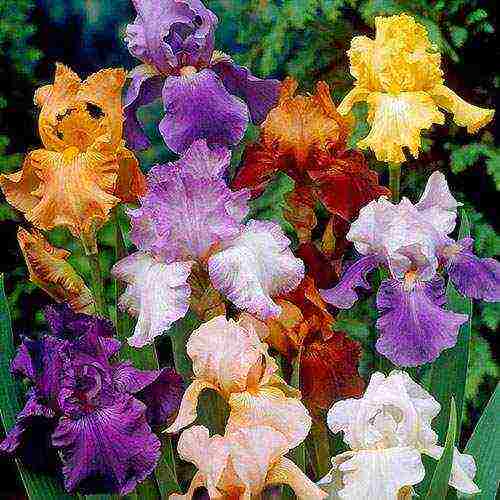 Irises have long gained popularity due to their unusual appearance and unpretentiousness. They are practically maintenance-free; even an inexperienced gardener can cope with the cultivation. A lot of varieties of this plant have been bred. In order not to get confused in such a variety, it is necessary to study irises, varieties with photos and names in advance. This will help create a spectacular garden that will be the envy of all neighbors.
Irises have long gained popularity due to their unusual appearance and unpretentiousness. They are practically maintenance-free; even an inexperienced gardener can cope with the cultivation. A lot of varieties of this plant have been bred. In order not to get confused in such a variety, it is necessary to study irises, varieties with photos and names in advance. This will help create a spectacular garden that will be the envy of all neighbors.
Varieties of irises
Iris is a perennial, unpretentious plant with an unusual shape and color of flowers. It is suitable for growing in open areas, flooded with sunlight. A distinctive feature of the flowers is their enchanting delicate aroma. Therefore, they are often used in the perfumery industry.
Wild-growing irises can be found today in meadows, in the steppe or on steep cliffs. In the conditions of greenhouses, about five hundred different varieties have been bred, which are suitable for growing in personal plots. They can be divided into several large groups:
- bearded;
- dwarf;
- bulbous;
- Siberian;
- marsh;
- Japanese.
In European countries, it is customary to divide these plants into 10 - 15 categories. Separately, there are border, Californian and some other types. To determine which of them will take root better on your site, study carefully irises, their varieties with photos and names.
Bearded irises
Bearded iris is considered one of the most common plant species. Its distinctive feature is the presence of fine hairs on the lower petals. They have a richer color in comparison with the general tone of the flower. Among the most spectacular varieties are:
- Cloud Ballet. The variety attracts with its touchingness and romance, which are emphasized by an elegant wavy edge and a pleasant white and blue color. In the aroma of flowers, notes of caramel and apple are caught.
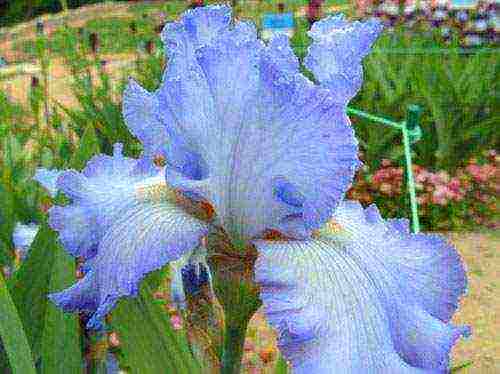
- Depeche Mode. The variety belongs to the category of flowers with a "broken color". On a delicate yellow background, a bright purple pattern appears, consisting of small strokes and thin lines.
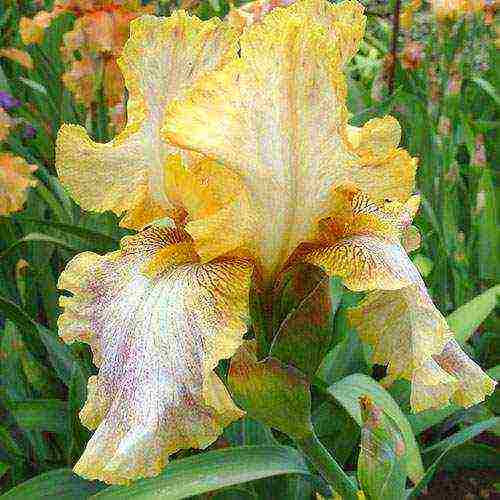
- Arabian Story. It embodies an exquisite combination of yellow and orange shades. The flowers are distinguished by a delicate aroma with notes of citrus.
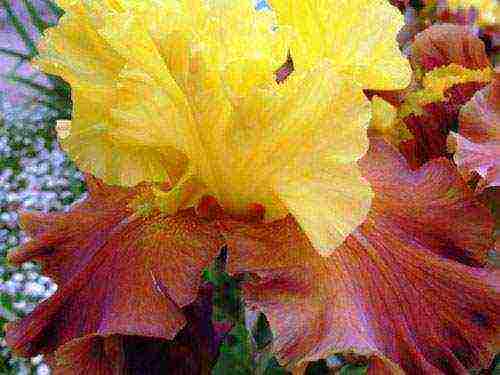
- Back in Black. Spectacular dark purple flower. From a distance, it appears almost black. Great for creating contrasting flower beds of an unusual design.
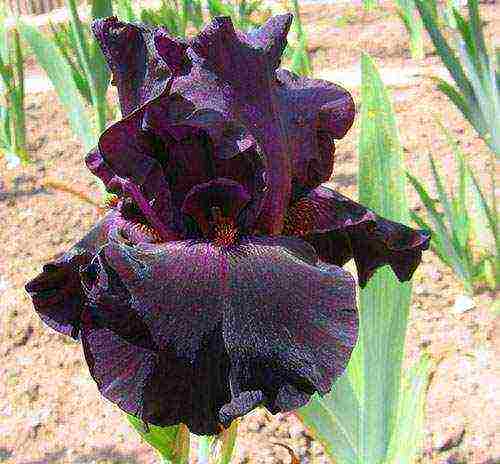
- Heritage Lace. This flower will be loved by connoisseurs of ageless classics. Like graceful lace, it creates an atmosphere of lightness and airiness.
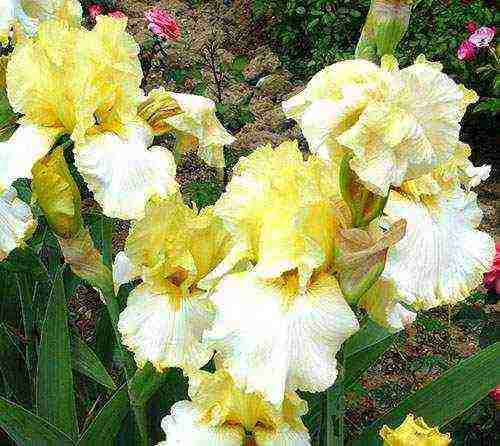
This is just a small part of all the variety on the market today. When choosing, pay attention to the fact that the flowers are in harmony with neighboring specimens and fit into the overall design of the site.
The height of such varieties can reach 80 cm, so you should not plant them in the immediate vicinity of light-loving low-growing plants.
Dwarf irises
Iris dwarf differs from its counterparts in small stature. The height of the peduncles does not exceed 40 cm. In most varieties, this parameter is even 20 cm. They will be ideal for decorating small compact flower beds. Among the most popular varieties are:
- Wink. An exquisite snow-white flower, which is framed along the edge with delicate blue petals. Two buds appear on one peduncle. The size of one flower does not exceed 9 cm.
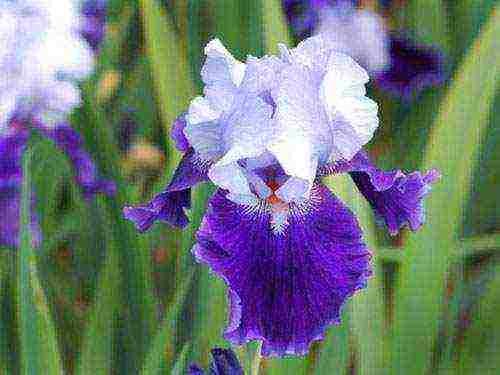
- Cry Baby. Young flowers are blue. Over time, they fade and become almost white.Up to three buds bloom on one peduncle.
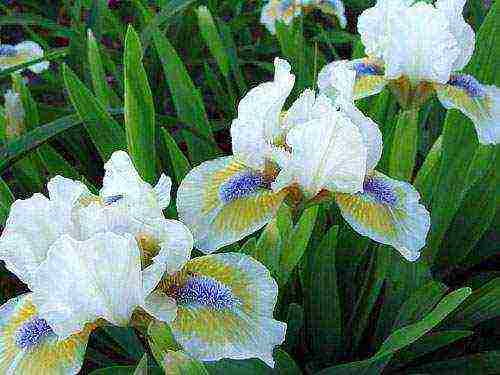
- Little Dream. The color of the petals can vary from gray to pale blue. The flower size does not exceed 10 cm in diameter.
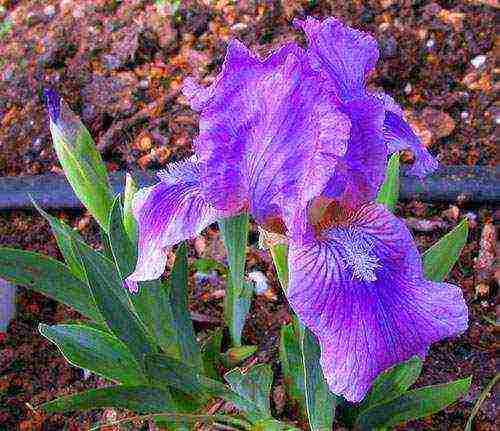
- Sapphire Gem. The petals are bright and rich in color. They show thin light grooves. The height of the stem does not exceed 37 cm. There are three or four flowers on one peduncle.
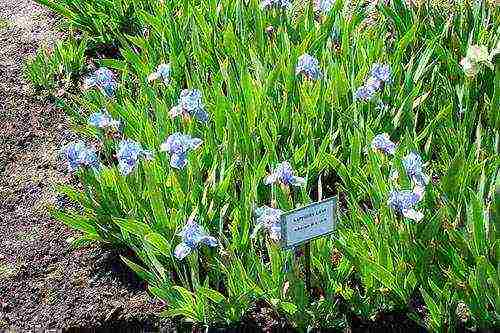
Dwarf irises thrive on light, moisture-permeable soils. If the soil in your garden is heavy, then add sand to it before planting.
Bulbous irises
Everyone is accustomed to the fact that irises are rhizome plants. Modern specialists have managed to breed several varieties that grow from bulbs. They are distinguished by their unusually early flowering. They can be compared to snowdrops. As soon as the snow melts, the first flowers appear. There are three main types:
- Iridodictum or reticulated iris. Plant height does not exceed 15 cm. In one place it can grow up to six years. Leaves appear simultaneously with the peduncle. The flowering period lasts for two weeks. Leaves and peduncles completely die off by mid-June. A distinctive feature of such flowers is a two-tone color, on which strokes of a contrasting shade are clearly visible. Popular varieties are: Dunford, Baker, Vinogradov and others.
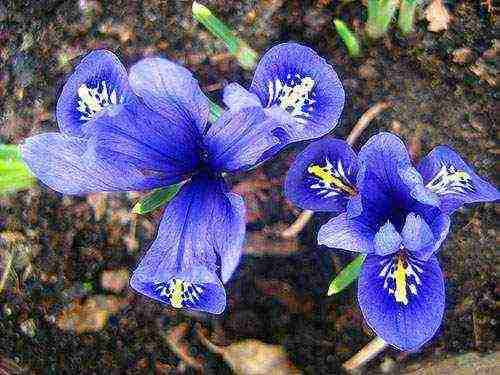
- Juno. This type of iris is considered rare. The flowering of such plants is observed in late May - early June. The height of the peduncles can reach 40 cm. The crescent-shaped leaves are arranged in several tiers. Up to five flowers can bloom on one peduncle. It is recommended to dig up the bulbs in July, dry them well and plant them back in September. Of particular interest are the varieties: Nikolai, Caucasian, Orchidnaya.

- Xyphyums or Dutch iris. This species is considered the most capricious. It will be possible to get beautiful flowers only if all the rules of agricultural technology are observed. Varieties of this species do not tolerate frost well. Therefore, the bulbs will have to be dug up for the winter. Since the price of xyphyum bulbs is low, many people prefer to grow them as an annual crop. Today on sale you can find a mix of Dutch irises. One pack of bulbs is enough to create a spectacular flower bed.
Bulbous irises look good in a flower bed with crocuses, muscari, galanthuses and so on. They are ideal for alpine slides.
These varieties can be grown in pots and large planters. They will be an excellent decoration for verandas and gazebos.
Siberian irises
Photos of Siberian irises are impressive. They are distinguished by the extraordinary beauty of flowers. The value of this species also lies in the fact that the foliage of the plant has a rich green color throughout the season. The most spectacular varieties are:
- Ester C.D.M. This iris is white with no blotches of any other colors. The flowers look light and airy. They seem to be hovering over the foliage. The variety is distinguished by large, wide leaves.
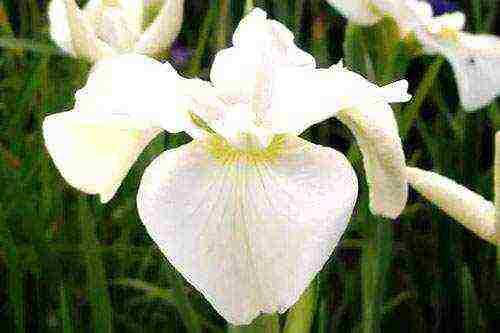
- Clarkei. The flowers are painted in delicate violet-blue tones. Small snow-white strokes stand out against their background. Peduncle height can reach 60 cm.
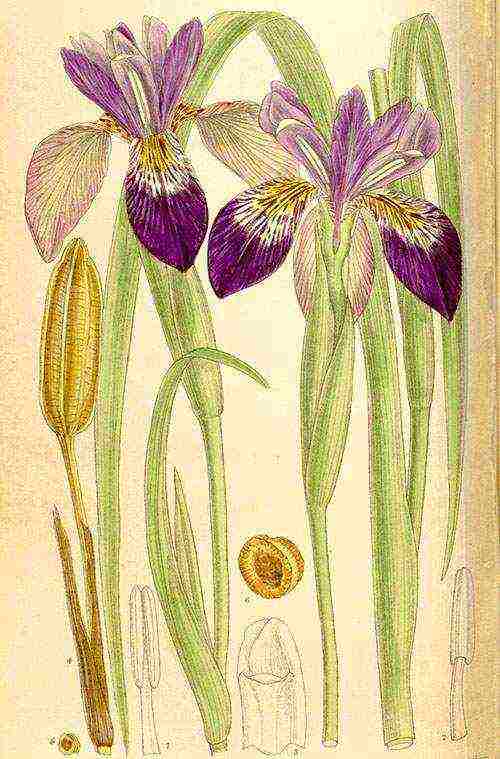
- Delavayi. This variety is distinguished by the shape of the petals. They are oblong and rather narrow. Painted in blue-violet color. Light stripes are visible on them. The peduncle does not grow more than 60 cm in height.
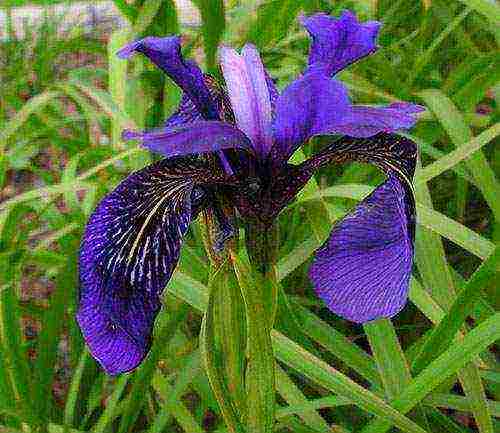
- Dykesii. Tall variety. The height of the peduncle can reach 90 cm. In the flower, dark blue petals alternate with deep purple. They have bright yellow strokes.
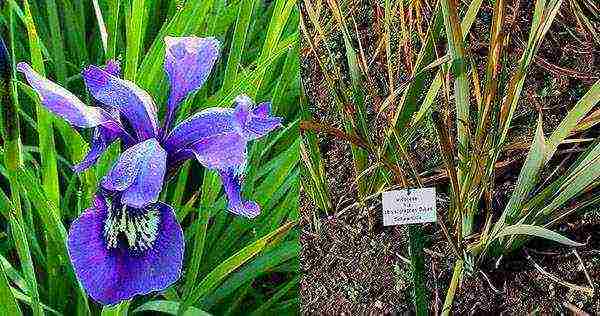
Such varieties look spectacular along the banks of improvised reservoirs, in large rockeries. Groups of such flowers can be used to decorate the lawn, which will make the landscape unusual.
Swamp irises
Marsh iris or iris grows everywhere in our country. The leaves of this species are xiphoid. Their length can be up to two meters. This species does well in partial shade. Therefore, such flowers can be planted along fences or near trees with a not too dense crown. Among the most popular varieties are:
- Veriegata. The flowers are medium-sized, pale blue.This iris iris is prized for its highly decorative leaves. They are bright green and have beautiful yellow stripes. The plant looks most impressive in spring. Closer to autumn, it loses its decorative effect.
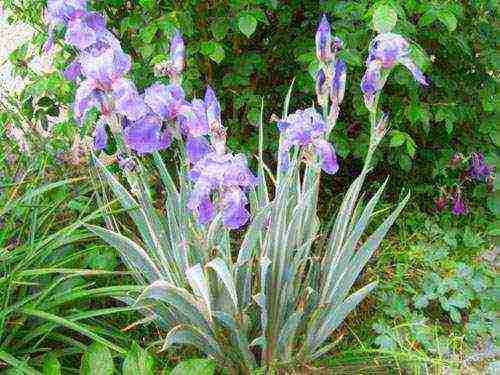
- Flore Plena. This iris is yellow. Terry flowers. They stand out brightly against the dark green foliage. The plant develops well provided there is sufficient moisture and a sunny color.
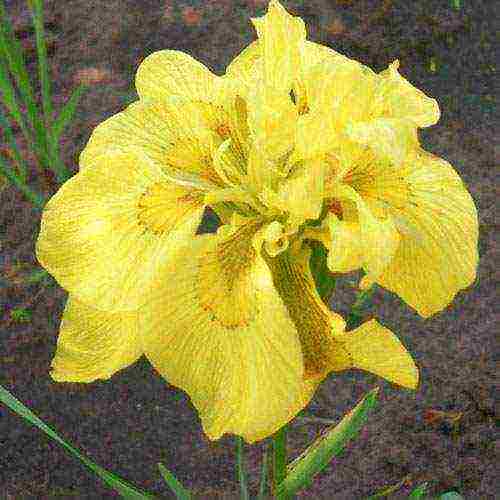
- Black Form. Spectacular deep purple flower. Small yellow strokes are visible on the lower petals. The height of an adult specimen does not exceed 50 cm.

Having studied these varieties of irises with photos and names, we can conclude that they are ideal for group plantings. With the help of different types of irises, you can create spectacular flower beds.
Japanese irises
Japanese iris has orchid flowers. Their size can vary from 15 to 25 cm. In Japan, such plants are planted so that they can be admired from a height. From this angle, they look most impressive. Plants are large, therefore, when planting between them, you must maintain a distance of at least 30 cm. The most popular varieties:
- The ghost of happiness. The flower has six petals. They are white in color and have pale pink stains. With age, the flower becomes completely white. Flowering is observed in mid-July.
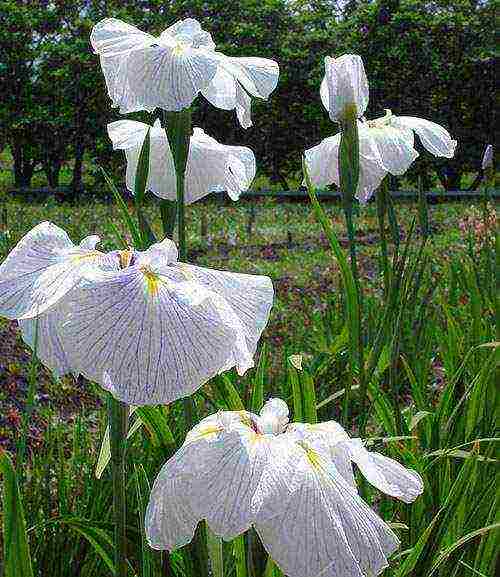
- Vasily Alferov. This is a giant plant, the height of which can reach 110 cm. It is distinguished by large dark purple flowers interspersed with yellow. The petals have a velvety texture. Flowering continues for 19 days. Three or four buds bloom on one peduncle.
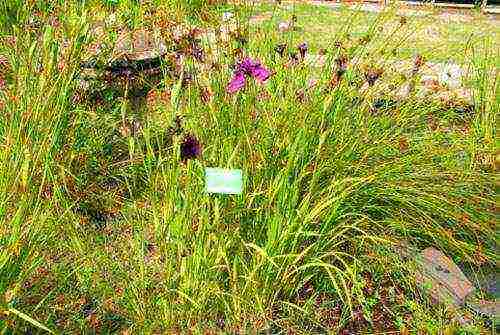
- Altai. Differs in pleasant lilac color of petals. Each flower has a small yellow tongue. Blooms for two weeks in mid-July.
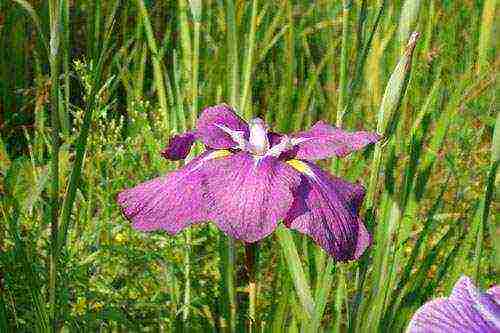
- Vivat Rodionenko. Flowers of this variety have six petals. They are painted in a delicate purple color. The petals have small bluish streaks and spots. A white pistil is visible in the middle of the flower. Two flowers bloom on one peduncle.
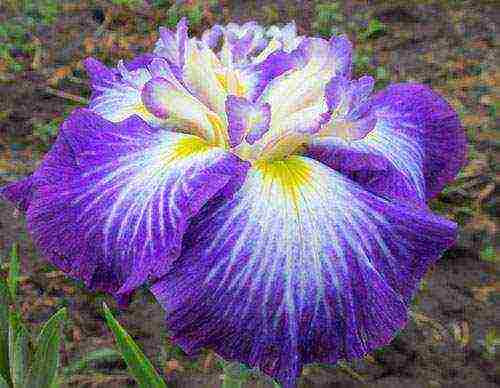
Having studied the photos of the varieties of iris varieties, you can choose the right planting material that is suitable for your soil type. If you choose specimens with different flowering times, you can admire the beauty of the flowers all summer long.
Irises bloom in the garden - video
What to look for when choosing an iris variety for the garden? Certainly to the height, at the time of flowering and, of course, to color. After all, some people like irises in a calm blue-lilac-violet tones, while others like something brighter.
But first, let's define the terminology.
Parts of an iris flower scientifically called so:
fouls - three lower petals;
standards - upper;
beard - thick bristly villi that run in a strip on the top of the fouls at their base, it serves as a landing site for pollinating insects;
styles - pistil outgrowths.
Tall irises
Large plants, in suitable conditions and with careful care, can raise flowers to a height of one meter. They are the soloists of the flower garden!
For instance, Florentine Silk (Florentine Silk). He has pink-peach, rather bright standards, lavender with a pinkish-beige border of fouls, orange-peach, white at the base and blue at the tip of the beard, peach-streaked styles.
The variety will not be left unattended Dance Hall Dandy (Dance Hall Dandy). The flower is topped with white, pale pink along the central vein, and slightly creamy standards at the top, contrasting with velvety reddish-brown fouls and a bright tangerine beard.
Want to add a sunny touch to your garden? Plant Orange King (Orange King) with a defiantly bright tangerine shade, lemon yellow with white Country Dawn or almost crimson red Rip City (Rip City).
The average size
Varieties with a height of 0.75-0.9 m in bearded irises are innumerable.
Looking for flowers for a monochrome white garden? We recommend white iris varieties: Arctic Age (Arctic Age) and space generation chic crimped iris Mesmerizer (Mesmerizer).
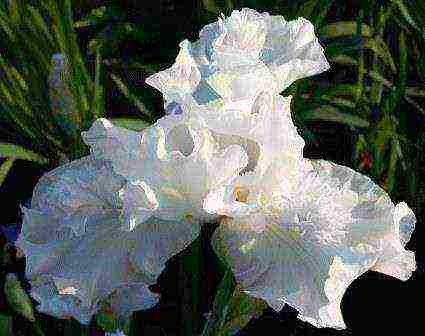
One of the bluest irises - Carribian Dream (Caribbean Dream). No worse than the Oregon Skies azure blue, exuding a vanilla aroma.
A real miracle of selection - Crowd Heads (Crowned Heads). A hint of purple wisteria on the standards, light blue styles, silvery blue crinkled fouls, and a light sweet scent.
For rich blue-purple accents (they are so lacking in our gardens!), Purple with a golden beard and lace edges of the standard variety are suitable Midday in Rio (Afternoon in Rio).
Or Gypsy Romance (Gypsy Romance), ruffled purple-crimson with a blue-purple beard.
A little softer Fancy Dress (Fancy Dress). He has a violet-blue with lighter veins, slightly darker, also veined fouls and a white beard with orange tips.
In color Andalu (Andalou) mixes bright yellows and reds, and the flowers smell like sweet lemon pie!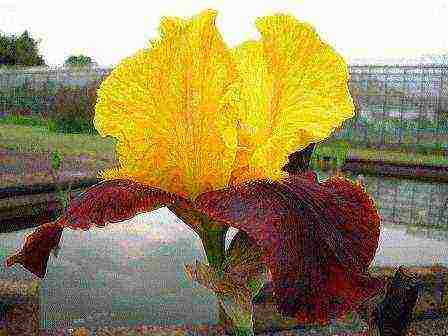
They are very similar to him Bracero (Brasero) and Marie-Jose Nat, in the same bright temperamental outfit.
Flowers that are black or almost black are perceived as a curiosity. Do you dream to surprise your neighbors and be branded as an original? Buy black-purple-violet Badlands (Badlands), velvety Fade to Black (Fade to Black), Obsidian (Obsidian) or Black Suited (Black Suited) with a pleasant nutmeg aroma.

Stunted irises
Dwarf bearded irises (height 0.25-0.35 m) can be planted even in rock gardens, where bearded irises of the usual sizes do not fit in any way! By the way, many babies have a pleasant aroma. But to feel it, you have to bend over.
Corrugated flowers of the variety are very beautiful. Nain Lives (Nine Lives). Standards and styles are creamy yellow, fouls are dark red-burgundy with a clear wide pinkish-white border. At the base of the fouls, olive-golden spots are noticeable, along and at the end of the golden and white beard, a pattern in the form of white rays.
Crazy about pink? This shade, pure and quite intense, has Pussiket Pink (Pussycat Pink). The fouls liven up the cocoa-pink veins. The goatee is pink-coral with a white tip.
Here are a couple more interesting varieties. Have Cats Eye (Cats Eye) standards and styles are lilac-pink, fouls are dark-purple with well-pronounced almost dark veins and a wide lilac-pink border.
And in coloring Ringer (Ringer) bizarrely combines shades of dark plum brown, lilac brown, pale yellow and even copper.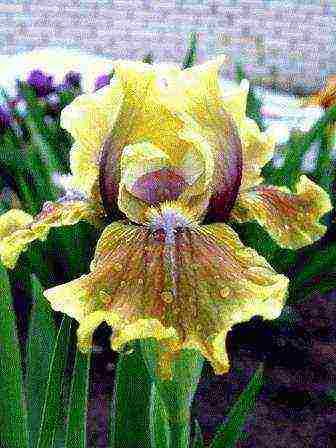
When choosing bearded irises for growing on your site, first of all, decide on the size. The fact is that these flowers are different in their height: there are bearded irises that grow up to 70 cm, and there are those that rise no higher than 5 cm above the ground. The best varieties of bearded irises must meet certain requirements, about them you you will find out by reading this material.
Medium, tall and miniature bearded irises
Bearded irises are the most extensive group of irises, consisting of several classes.
Tall Bearded Irises (TV) - powerful plants with a height of 71 cm with a branched peduncle, many buds and large, sometimes up to 20 cm in diameter, flowers. In the suburbs, they bloom from mid-June to early July.
Medium-sized bearded irises (MB) - from 41 to 70 cm in height, are subdivided into three groups:
- border irises (BB) with a flowering period similar to a tall bearded one, but with a proportionally smaller flower;
- intermedia irises (IB) with a flower size of 10-13 cm and a flowering period in the Moscow region from the beginning of June; not necessarily highly branched, but forming a profusely flowering bush;
- dining rooms, or miniature tall bearded irises (MTB) - with a high thin branched peduncle and relatively small (no wider than 8 cm) flowers, used mostly for a bouquet and a table, hence their name.
Standard Bearded Dwarfs (SDB) - 21-40 cm high, bloom in the Moscow region from the end of May.
Miniature Bearded Dwarfs (MDB) - the smallest, the height of such bearded irises is 5-20 cm. These flowers bloom very early (in the Moscow region from the first half of May).
Requirements for tall bearded irises
The modern tall bearded iris is a striking flower! Anyone who sees him is fascinated by his beauty and extremely surprised when he learns that growing luxurious irises is no more difficult than any other garden flowers or even vegetables in the garden. Perhaps, there have not been so many erroneous opinions about any culture that many, even very sophisticated gardeners, are wary of it, usually opposing new varieties to old ones. And it is completely in vain: among modern varieties there are plenty of those that can reliably and regularly bloom in the middle lane and even have some advantage in resistance to the adversities of our harsh climate compared to historical varieties. Therefore, undoubtedly, it is worth striving for the acquisition of new varieties. But the main advantage of the new varieties is that they are immeasurably more beautiful than the old ones.
The progress of flower breeding for tall, bearded irises is astounding. The main focus is on the flower, because even just one flower - whether it grows in a garden or stands in a vase - is able to conquer the gardener's imagination and fall in love with itself forever. Until now, new color combinations appear, exquisite color patterns, instantly gaining immense popularity. But, despite all the achievements in expanding the color range of irises, the main focus is on the quality of the flower.
The quality of a flower means:
- wide halyards, sometimes closing at the bases and closed standards, making the flower collected, rounded and expressive;
- the density of the texture of the petals, which ensures resistance to atmospheric precipitation and a longer life of the flower;
- grace and uniformity of the corrugation of the shares;
- width, density and expressiveness of the barbs.
An example of great flower quality is Keith Keppel's ‘Paris Fashion’. Giant flowers also require peduncles proportional to their size - tall, strong, resistant to gusts of wind. So that the opening flowers do not interfere with each other, they must be "spaced" on sufficiently long branches, and in order to ensure a long flowering duration, there must be a large number of buds in the inflorescence.
Particularly attractive are the so-called exhibition varieties with 3-5 simultaneously opened flowers on a peduncle.
Considerable attention is paid to the garden attractiveness of iris - the health of the foliage, the rapid growth of the bush and the representativeness of its flowering, when the optimal number of peduncles on the bush, approximately equal to half the number of leaf fans.
Of particular interest are those varieties, the bushes of which do not emit flower stalks simultaneously, but over a period of time, providing exceptionally long flowering. Remontant varieties have long flowering.
With the correct selection of varieties, the flowering of tall bearded irises stretches for 50 days.
The main requirement for iris varieties for growing in the northern regions is growth energy, it allows you to compensate for many other plant shortcomings. The next most important quality is frost resistance. The ability to withstand low temperatures in winter is related to the rhythm of plant development. Irises, whose growth ends by the end of summer, and the leaves die off, winter much better and, therefore, their flower buds are not damaged in severe winters.
Tall bearded irises are a very thermophilic culture. So, in the Moscow region and to the north, only 20% of varieties of their total number are successfully growing. Therefore, my advice to amateur gardeners is to be interested in its frost resistance when buying.
Resistance to fungal and bacterial diseases is another important quality. Resistance to bacteriosis and heterosporiosis ensures healthy foliage, decorative planting and regularity of flowering.
The standard planting unit for bearded irises is usually a one-year iris rhizome growth. In the middle lane, they reach acceptable sizes by the beginning of August.This is the reason for the recommended planting time - the first half of August, however, good results can be obtained when planting before the beginning of September.
What rhizomes are better for planting: large or small, annual (short) or biennial (long)? The answer to this question depends on your goals: if you, by all means, want to see an iris flower the next year after planting, choose a large rhizome with a wide fan of 6-8 leaves. If flowering for the next year is not important for you, and the reliability of overwintering and plant survival are of paramount importance, choose a medium-sized one-two-year rhizome with a diameter of 2-2.5 cm, with 3-4 leaves.
Agricultural technology for growing bearded irises: planting and care
The agricultural technique of growing bearded irises depends on the purpose of their cultivation, so it is impossible to give any universal scheme. Some grow irises, planting and annually digging planting material, usually for sale. Others plant irises to decorate the garden in a curb, mixborder, rockery or on a rocky hill, where it is advisable not to touch them for several years.
Light and drainage are the most important factors for successful cultivation. Also remember that irises are heat-loving plants. The more sun the irises receive in the garden, the better they bloom. A little shade in the morning or evening is, of course, acceptable, but only a few varieties of irises, such as the 'In a Flash' intermedia, will withstand a more serious shade. The southern slopes are preferable to the northern ones; a place near the southern wall of the building will also be good. It is good if the landing site is cleared from the prevailing cold winds.
With excessive soil moisture, the respiration of the roots is disturbed, and they partially die off, this leads to a slowdown in the development of plants.
In such conditions, bacterial rot also develops on the rhizomes of irises.
If the soil is sufficiently drained, irises can be planted on a flat surface, if the soil is heavy, clayey, then it is better to plant them on a hill or on ridges. The ridges are also more convenient from the point of view of arranging a winter shelter.
High soil fertility is the key to successful cultivation and productivity of tall bearded irises in central Russia.
Bearded irises work best on light sandy soils. Loam is also acceptable, but the addition of sand and organic materials (peat, composted sawdust, humus) significantly improves the structure and permeability of the soil, which leads to excellent results. It is only necessary to take into account that to improve the soil to a depth of 20 cm, it will be necessary to add about 100 liters of sand per 1 m2 of soil.
The optimum level of reaction of the soil medium (pH) is 6.8.
If you intend to grow irises on ridges, then their preparation consists of the following operations:
- freeing the site from the roots of perennial weeds;
- delivery of compost or other available organic material to the site;
- leveling organic matter on the site with the simultaneous introduction of wood ash or dolomite flour and mixing them with the soil with a pitchfork or a shovel.
- introduction of mineral fertilizers under a rake: potassium sulfate and superphosphate, as well as ground or colloidal sulfur in an amount of 5-7 g / m2;
- shaping the profile of the ridge and compaction of the soil to avoid its further subsidence and bulging of newly planted plants. The height of the ridge profile after compaction is approximately 7-8 cm;
- delivery of coarse-grained river or washed quarry sand to the ridges in such an amount to form a layer of about 5-7 cm, and its leveling;
- the ridge is ready for planting. To preserve the structure of the ridge, it is convenient to plant the bearded irises as follows: slightly push the sand apart by sticking a spade bayonet into it, place the roots of the iris cut into the gap, compact the soil around the roots and water the substrate to the planted iris cut so that it is in the layer sand.
Delenki are planted on the ridge in such a way that the trimmed part of the rhizome is directed to the edge of the ridge, and the fan of leaves is towards the middle. In this case, the growing roots will be directed towards the center of the ridge, which will facilitate further watering of the plants in the groove in the center of the ridge.
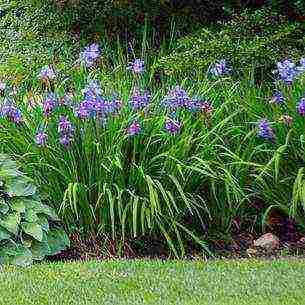

Irises can be replanted at any time during the growing season. However, replanting in spring can result in poor flowering this year. In the middle lane, optimal results are obtained when planting and transplanting irises in August: the plants have enough time for rooting and gaining sufficient mass to fully bloom next year. Irises planted later, that is, in the fall, usually remain healthy, but do not have time to take root before the onset of cold weather. This can lead to bulging of rhizomes from the ground when the soil freezes. To avoid protruding rhizomes, additional mulching for the winter is required, or simply fixing the rhizome with a suitable improvised object.
Irises love space, usually the recommended distance between plants is 30-50 cm. Delenders of the same variety can be planted closer, however, it is necessary to ensure that the fans of their leaves are directed in opposite directions.
When replanting an old bush, do not try to preserve all the shoots. Planting two or three large fans will give better results than 5-10 small ones.
A common mistake when planting and caring for bearded irises is over-deepening the rhizome. It is recommended to plant irises so that the back of the rhizome is at the surface of the soil. For the winter, it is better to sprinkle the open rhizome with soil, and in the spring it needs to be shaken off.
When caring for bearded irises, watering is required in the first weeks after planting irises for successful rooting. For adult specimens of bearded irises, watering is necessary for abundant flowering only when there is a lack of rainfall, especially in May, when there is often hot dry weather, sometimes in June-July. However, in August and even more so in September-October, adult bushes no longer need watering. At this time, the plant is preparing for winter, and its growth should not be stimulated.
Top dressing for irises should be given both in early spring and 3-4 weeks after flowering. A quick effect is given by top dressing with soluble fertilizers: in spring - complex with microelements, in July-August - with potassium phosphate.
For the successful cultivation of bearded irises, phosphorus is the most important from the main nutrients, so it is advisable to fill the soil with superphosphate (100 g / m2) or bone meal (200-300 g / m2) when preparing a plot for irises. For spring-summer dressings, you can use a complex fertilizer with a low nitrogen content, for example, NPK = 6: 10: 10. The autumn mixture has a NPK ratio of 0: 13: 18, it also contains magnesium and elemental sulfur, the latter being 5%. The spring feeding mixture has the formula NPK = 8: 37: 11.
The best organic fertilizer for irises is well-rotted compost.
Bearded irises successfully grow in one place for 4-5 years. The specific timing of the renewal of the bush depends on both the variety and the agricultural technology used. Some time after planting, the iris bush thickens, which ultimately leads to the cessation of flowering. How quickly thickening occurs depends on the multiplication factor of the variety. Some varieties are also characterized by vigorous growth, and at the same time they are not too demanding on external conditions.
With the age of the bush, it is desirable to increase the amount of dressings. If these measures do not bring the desired effect, the bush must be dug out entirely, the soil must be renewed by adding ripe compost and phosphorus-potassium fertilizers, and the 3-4 strongest shoots must be planted, shortening the leaves by about 2/3.
Many modern varieties do not need shelter for the winter. If the variety is chosen for the beauty of the flower, but is not winter-hardy enough, additional efforts will be required in preparation for winter. The main problems for irises in winter in the middle lane arise when an ice crust forms on the frozen ground without snow, which prevents the respiration of plants.
It is convenient to cover irises with spruce branches or oak leaves, which tend not to cake. To prevent such a frame from getting wet, it must be covered with a non-woven covering material or a film - under them the irises will not adhere in winter.
Irises winter best under a dry air shelter with preliminary drying of the ridge, which is usually enough for one month. The easiest way to protect from rain is with a dense reinforced film laid on arcs or directly on the iris foliage. At the same time, the ends of the shelter should be open for free air circulation, and they must be closed for the winter. The tentative time for the construction of the shelter is the end of October - the beginning of November.
In the spring, the film is removed from the shelter as early as possible, immediately after the snow melts, and other material - as needed.
Varietal irises are propagated vegetatively, that is, by dividing the rhizomes. For accelerated reproduction, you need to remove the flower bud located at the base of the fan of leaves in the fall. After that, the lateral buds of the plant begin to grow, which in the spring form new powerful shoots. You do not need to dig out the rhizome to separate them. On a dry, sunny day, you need to shake off the ground, cut off the dried and yellowing leaves, and cut the remaining green leaves to the rhizome. The cut must be disinfected and left to dry in the sun. After a few days the wound is healed, the rhizome must be mulched with soil so that roots can form in the awakening buds. The division of the rhizome into kidney cuttings, which is often recommended for the propagation of irises, is a much less effective method, since in this case the plant is severely injured and, as a result, flowering occurs much later.
For reproduction, dormant buds on 2-3-year-old links of rhizomes can be successfully used. To do this, pieces of rhizomes are cut out from the middle of the bush and simply transplanted to a new place.
New varieties of tall bearded irises for the middle lane
The following are photos, names and descriptions of new varieties of tall bearded irises for the middle lane, recognized by gardeners as the best for growing on the site.
The description contains the following data: name of the bearded iris variety, originator, year of registration, characteristic of the flower, flowering period.
Sundress
Pirogov 2000
The top is golden smoky with a lilac bloom. Purple dots and strokes, golden smoky border along the white field of the bottom. Bright yellow pistil ridges glowing in the depths of the flower. Exceptionally vigorous growth and regular, profuse and long flowering. Early.
Queen
Sholupov 2003
Intense purplish violet with velvety texture and powerful crinkle. The show peduncle easily holds several open flowers at the same time. Average flowering time.
Cranberry Sauce
Black 2002
Cranberry South
Silky-shiny flower with lilac-crimson overflow. The yellow beards accentuate the great depth of color. Average flowering time.
Darcy's Choice
Schreiner 2007
Aarsis Chois flower of original color with white beards on crimson halyards. Wonderful branched peduncle. Average flowering time.
Dawn To Dusk
Schreiner 2008
Aone To Dask
A two-colored pink-purple flower that takes on a unique gray tint on acidic soils: unexpected and attractive. Medium late.
Edgefield glow
Schreiner 2011
Edgefield Glow
Orange flower of exceptional brightness with dark tangerine beards. This new variety of bearded irises has an incomparable color and excellent growth vigor not found in other orange forms. Medium early.
Never been kissed
Blyth 2008
Never Win
Kissed Fashionable reverse: blue top and pure white bottom. Luxurious flower of delicate color. A distinctive feature is the best corrugation to date. Medium early.
Palace symphony
Blyth 2007
Palace Symphonies
A purple-wine flower with almost black beards and exceptional corrugation. A variety that combines the best features of American and Australian breeding. Average flowering time.
Royal birth
Royal 2003
Royal Burf
Creamy white with golden halyard bases. Dense flower texture. Abundant flowering and steady growth. Medium early flowering period.
Undivided Attention
Ernst 2004
Antiwaged Attension
Deep pink, warm salmon color, denser in the center of the flower. Bright coral beards. Abundantly flowering cultivar. Medium late.
Warranty
T. Johnson 2004
Warranty
A huge hovering purple-black flower with a velvety texture on a tall peduncle. Medium late flowering period.
Main page ›Forums› Flower garden and landscape ›Ornamental plants and their care› Interesting varieties of bearded irises
This topic has 32 replies, 4 members, last updated by Maxim Savinov 1 month, 1 week ago.
Viewing 30 posts - 1 through 30 (of 33 total)
-
author
Posts
-
In this thread, I propose to lay out interesting varieties of bearded irises. It can be not only new, but proven and loved ones. The basic rule is that you need an accurate title and a good quality photo.
Bearded iris "Champagne with strawberries"
Tall Bearded Iris 'Champagne and Strawberries'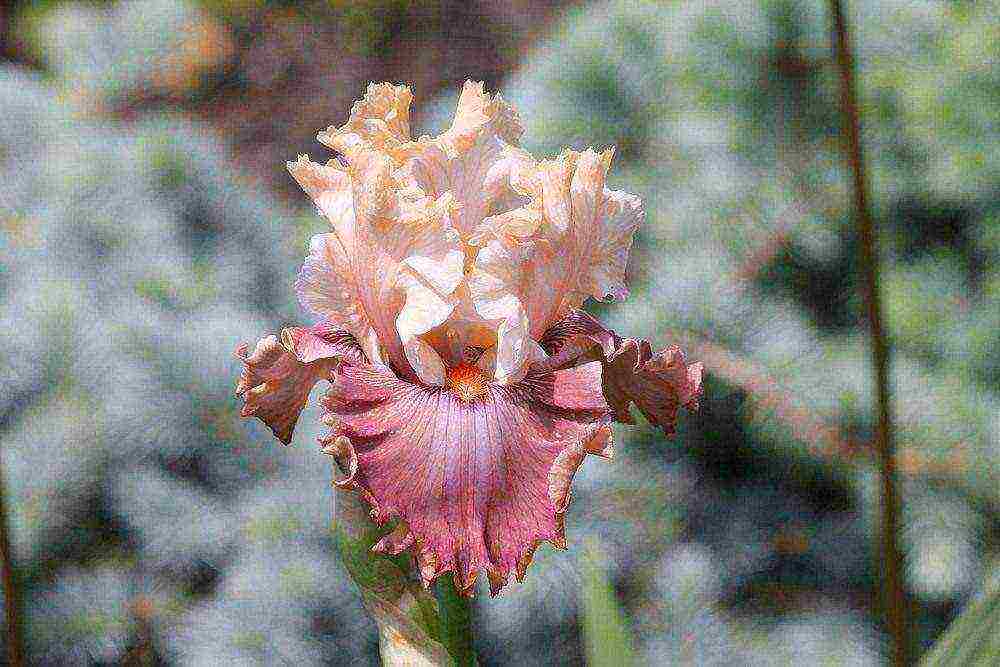
Selection: Barry Blyth.
The year of registration and introduction is 2007.Investments:
Viewing 30 posts - 1 through 30 (of 33 total)
You must be logged in to reply to this topic.


